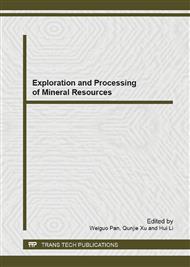[1]
Shenghou He, Xiusheng Li, Lei Chen. Technology and Principle of Chemical and Thermal Recovery [M]. Jinan: Shandong Science & Technology Press, 1992, 51-108. (in Chinese).
Google Scholar
[2]
Moore, T.F. and Slobod, R.L. The Effect of Viscosity and Capillarity on the Displacement of Oil by Water [J]. Producers Monthly, 1956, August(20): 20-30. (in Chinese).
Google Scholar
[3]
Yanli Jiang. Parameter processing in the process of numerical simulation of surfactant flooding [J]. Petroleum Geology & Oilfield Development in Daqing, 1985, 4(3): 41-52. (in Chinese).
Google Scholar
[4]
Yanli Jiang. Prediction of the relationship between capillary number and residual oil saturation [J]. Petroleum Geology & Oilfield Development in Daqing, 1987, 6(1): 63-66. (in Chinese).
Google Scholar
[5]
Ping Lu. A Study on the Factors Affecting Sweep Efficiency in the Sand Core [J]. Journal of Hydrodynamics, 1987, 2(1): 75-79. (in Chinese).
Google Scholar
[6]
Jirui Hou. Study of Synthetic Effect on Interfacial and Rheologic Properties of ASP Solution on Displacement Oil [D]. Ph. D. Thesis, Dalian, China: Dalian University of Technology, 2005. (in Chinese).
Google Scholar
[7]
Dong Han, Pingping Shen. Principle and Application of Surfactant Flooding [M]. Beijing: Petroleum Industry Press, 2001, 200. (in Chinese).
Google Scholar
[8]
Gang Tang, Huabin Li. Study on relation between interfacial tension and displacement efficiency of ASP flooding [J]. Petroleum Geology & Oilfield Development in Daqing, 2005, 24(3): 81-83. (in Chinese).
Google Scholar
[9]
Zhonghua Chen, Huabin Li, Baoge Cao. Study on the relation between Level of IFT and Enhanced Oil Recovery. Offshore Oil, 2005, 25(3): 53-57. (in Chinese).
Google Scholar
[10]
Taoping Chen, Nan Li. Experiments of SL surfactant flooding for EOR in low permeability reservoirs. Journal of Daqing Petroleum Institute, 2005, 29(6): 45-48. (in Chinese).
Google Scholar
[11]
Taoping Chen, Chunsheng Pu. Study on ultra low interfacial tension chemical flooding in low permeability reservoirs. Journal of Xi'an Shiyou University, 2006, 21(3): 30-33. (in Chinese).
Google Scholar
[12]
Qinglai Yan, Qiuxuan He. Research on oil/water flow in low permeability reservoirs [M]. Beijing: Petroleum Industry Press, 1993. (in Chinese).
Google Scholar
[13]
Yanzhang Huang. Flow mechanism in low permeability reservoirs [M]. Beijing: Petroleum Industry Press, 1998. (in Chinese).
Google Scholar
[14]
Taoping Chen, Xiaojiao Zhang, Bin Liu. The Reasonable Displacement Rate of The Weakly Water Wet Cores for Low Permeability Oil Layers. Journal of Daqing Petroleum Institute, 2011, 35(3): 50-54. (in Chinese).
Google Scholar
[15]
Demin Wang. Four Theories Affacting the Continuing Development of Daqing Oil Field and the Opinions on the Problems of Processing Technology. Petroleum Geology & Oilfield Development in Daqing, 2002, 21(1): 10-19. (in Chinese).
Google Scholar


